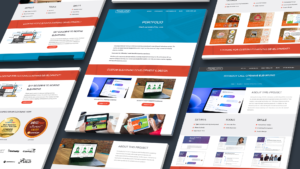
3 Ways to Develop Your eLearning Graphic Design Skills
Whether you’re designing an eLearning course, a presentation, or some other type of media, you want it to look good. For some of us, though, that can be a bit of a challenge. We all have the ability to be better eLearning graphic designers, but it’s not likely something we can master just by reading a book or taking a class. I like to think of eLearning graphic design as a muscle that can be strengthened and grown—it just needs to be exercised on a regular basis.
For instance, I’ve been trying to lose an extra 30 pounds for the past several years with little success. Although I’ve become an expert on every weight loss technique, routine, and diet, I just can’t seem to shake off the extra weight. Is this because I haven’t educated myself enough about weight loss? Absolutely not! The reason I haven’t lost weight is because I haven’t gone to the gym to apply what I’ve learned!
Becoming a stronger eLearning graphic designer is no different. It takes determination, time, and practice. Here are three ways you can exercise your graphic design muscles.
1. Challenge Yourself
It’s easy to stay in your safe zone when practicing any new skill. Unfortunately, we all know that growth doesn’t occur unless you push yourself outside your comfort zone. One of the best ways to become a stronger graphic designer is by investing time to practice. This means investing time outside of your day-to-day projects to try something new.
Try joining an online design challenge. David Anderson from the Articulate E-Learning Heroes Community hosts weekly e-learning challenges, many of which are design-focused. Weekly challenges are an excellent opportunity to push your skills, try something new, and receive constructive feedback in a positive environment.
I also suggest trying a technique- or tool-focused online tutorial. Let’s say you’re working to learn how to use Adobe Illustrator. There are countless online tutorials that walk you through the process of creating a graphic or using a particular technique step-by-step. I like doing this when I want to learn how to use a specific feature through a practical exercise.
2. Find Sources of Inspiration
Seeing the work of others can be intimidating, especially when their abilities seem light years ahead of your own. But if you change your perspective, there’s a lot you can learn from analyzing the work of others.
Finding inspiration is easier than ever–it’s just a Google search away. Here are some of the places I get design inspiration:
- Design category of Pinterest
- Bēhance
- E-Learning Examples section of the Articulate E-Learning Heroes Community
So, once you’ve found a good source of inspiration, what do you do with it? The key to using the work of others is not to let it intimidate you; but rather, use it to help you learn and grow. I like to analyze the work of others to understand the different techniques used to create the final result.
The next time you look at a source of inspiration, try looking at it from a technical perspective. Try drawing conclusions about the techniques or rules used to create the finished product. It might be helpful to know the principles of graphic design so you can recognize them and use them in your own work.
3. Ask for Feedback
One of the hardest aspects of learning any new skill is asking for and receiving feedback. Although feedback can hurt, you have to think of it as your friend. Understanding your strengths and weaknesses can help you focus your future efforts.
When it comes to eLearning graphic design, I like to ask for feedback from both graphic and non-graphic designers. A graphic designer can help you uncover technique-related issues in your design. On the other hand, a non-graphic designer can help you understand how the average person will view your design. Unless your audience is a bunch of graphic designers, most of your work will be viewed by the average person–their opinions count!
Finally, I suggest you get feedback from yourself—not on your current eLearning graphic design work, but on your past work. This is an exercise I practice on a regular basis. Looking back and analyzing your past work can help you discover how you’ve grown and realize your strengths. Looking at your past work gives you an opportunity to question what you would have done differently and helps you avoid the same mistakes going forward.
Becoming a better eLearning graphic designer is a journey that is unique to each individual. Learning to challenge yourself, seek inspiration, and obtain feedback are simple ways to help the process gain momentum.
What other ways do you exercise your eLearning graphic design muscles? Share your tips by commenting below!






